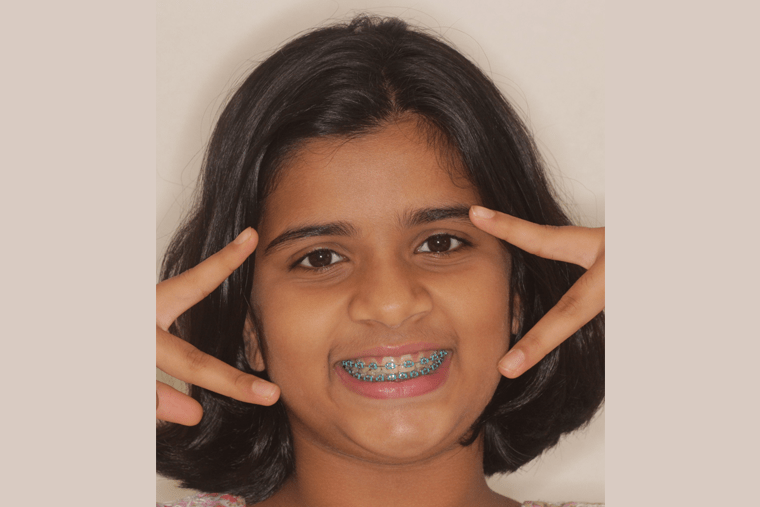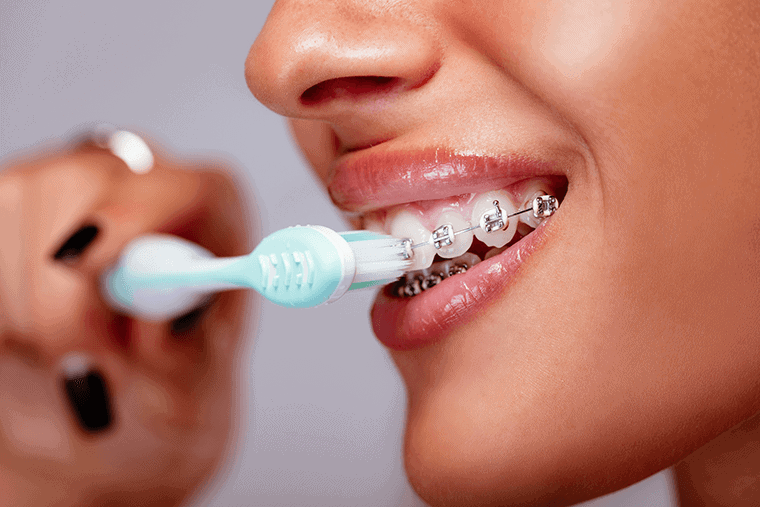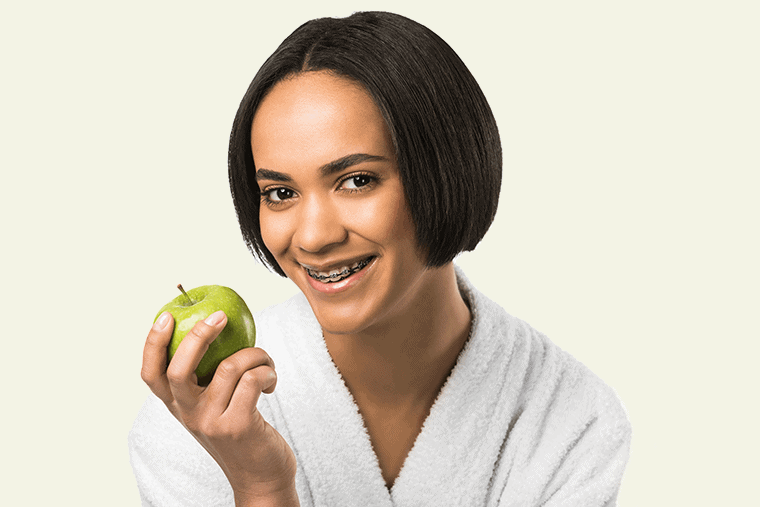Having braces on, you should know how to take care of them. It’s important for you to know and follow proper care instructions throughout your entire orthodontic treatment.
First Days of Braces
Congratulations! you got your braces on. It is indeed one of the most positive steps you have taken to improve your facial appearance and health of your teeth. Though this is a long term treatment, the days will fly past through which you will notice gradual positive change in your teeth and face which will change your life.
At SMILES N FACES we strive to make your association with us a pleasant experience which you will cherish throughout your life.
After you put braces first few days are required for you to get used to the braces. During these first few days you may experience following things.

1. Your teeth are sore specially while eating.
As the teeth start shifting to their new position with the pressure from wires, they exert pressure on surrounding bone and periodontal fibres. Due to this pressure, the surrounding blood vessels get squeezed and blood supply to the bone is reduced. This leads to changes in the bone with formation of pain mediators and you feel pain in the teeth. The pain typically is maximum on the first day which reduces gradually over the next three days. On the fifth day you may have little or no pain.
To minimize the initial pain,
- Chew on sugar free gum ( Orbit ) with chewing surface of teeth only, 4 to 5 times a day. Do not allow gum to stick to the braces.
- Take pain killer medicines which have been prescribed to you.
- Continue eating regular food. Do not go on liquid or very soft diet just because it hurts while eating.
2. You are developing painful ulcers / cuts in mouth
In our mouth, the tissues lining the inner cheek and lips is very soft and delicate. Presence of braces and wires irritates them due to constant friction between the tissues and the braces. This may lead to development of small ulcers or cuts in those friction areas. Gradually, there is keratinization of that area and the ulcers heal. Unless there is something really sharp that constantly cuts into the lip or cheek, you will be absolutely normal within a week.
To minimize the discomfort,
- Do warm saline water gargling 5 – 6 times a day.
- Apply the medicine which has been prescribed on the cuts.
- Do not pull your lips over the braces.
- Use the relief wax to cover the pokey part of the braces.
- Keep wet cotton rolls between cheeks and braces to minimize the discomfort.
- Contact office immediately if the cuts and pain persist even after a week. You may be requiring additional adjustments of the wires by the Orthodontist.
3. You are not able to close your mouth completely. Some of your teeth can not meet.
Sometimes, Orthodontist may glue bite blocks ( bite turbos) to your molars to raise the bite. Even if it is very uncomfortable initially, don’t worry you will learn to eat your food with turbos.
4. Your teeth seem to shake more than normal.
This is absolutely normal. When your teeth start shifting, remodeling resorption and deposition of new bone takes place around the teeth. This may cause some teeth to shake a little during the treatment due to widening of periodontal ligament space. After your braces treatment completes the tooth mobility returns to physiologic level during the retention period.

Maintaining Good Oral Hygiene
It is important to maintain good oral hygiene during your orthodontic treatment so that your teeth remain healthy and shiny throughout the treatment. Braces makes it difficult for you to brush your teeth therefore using orthodontic brush and correct brushing techniques are of utmost importance to keep your teeth speckless and free from white spot lesions, dental cavities and gum disease.
- Brush your teeth after you wake up in the morning, before you go to bed in the night and after every meal
- Use special orthodontic brushes and interdental cleaning aids / waterpik device to clean your teeth. Flossing may be needed in few patients.
- Regular use of fluoride toothpastes, remineralizing toothpastes and use of fluoride rinses once a day keeps the teeth enamel resistant to teeth decay
- Avoid sugary food and soft refined carbohydrates which may form dental plaque easily
- In case you notice white chalky spots on enamel, bring it to the notice of your doctor
At your 6 weekly appointment with us, we examine your teeth carefully and look for efficacy of your oral hygiene. We also look for any appearance of white spot lesions on teeth enamel or dental decay. In case some deficiencies are found, we will reinforce oral hygiene instructions, do fluoride applications and recommend dental prophylaxis.
Eating with Braces
A day after you have your braces on, you will have difficulty in eating normal food. You may have pain and discomfort while having food that requires chewing. You need to take pain relieving medicine and rinse with warm salt water to reduce the pain and discomfort. Over next 3 – 4 days the pain will disappear and you will be able to eat your favorite food. However, before you can start enjoying some of the treats you love, you will need to take special care to avoid any foods that could damage your new appliances. Hard and sticky foods as well as bad habits do damage to braces and teeth which can lengthen time braces are on.

Foods and habits to avoid with braces:
- Chewy foods – tough meats, bagels etc
- Crunchy foods – popcorn, chips, ice
- Sticky foods – caramel candies, chewing gum, chocolates
- Sugary food – sugary candies, toffees, sugary chewing gum.
- Hard foods – nuts, hard candies, whole apples, raw carrots, corn on the cobb
- Foods that cannot be cut, chopped, or sliced into smaller pieces
- Break habits of nail biting, pen chewing and opening things with your teeth
Foods you CAN eat with braces:
- Dairy – soft cheese, pudding, milk-based drinks
- Breads – soft tortillas, pancakes, muffins w/o nuts
- Grains – pasta, soft cooked rice
- Meats/poultry – soft cooked chicken, meatballs, lunch meats
- Seafood – tuna, salmon, crab
- Vegetables – mashed potatoes, steamed spinach, beans
- Fruits – cut apple, bananas, fruit juice
- Treats – ice cream w/o nuts, milkshakes, soft cake
- Gum – as long as it’s sugarless

Take Care of your Appliances and follow instructions
Damaged appliances can increase the length of your treatment process, so be sure to take care of all your appliances. Avoid eating hard food that can break the braces. Protect your teeth and face from injury. Do not fiddle with your braces with fingernails, pen, pencil etc.
Your teeth and jaw can only move into their correct positions if you do not damage the braces, do not miss your appointments, follow hygiene and care instructions and consistently wear the rubber bands, headgear, retainer, or other appliances prescribed by your doctor.
Playing Sports with Braces
You can still play sports even while undergoing orthodontic treatment! If you do play sports, it’s recommended that you wear a mouthguard in order to protect your teeth and your appliance. Let your doctor know if you need help finding the right mouthguard for the best protection.
In case of a sports emergency, be sure to immediately check your mouth and your appliance for any damage that may have occurred. If you notice any loose teeth, or if your appliance has been damaged, please contact our office right away. You can temporarily relieve the discomfort with wax or by rinsing your mouth with warm saltwater.


